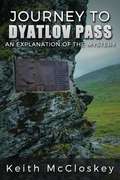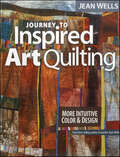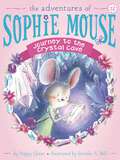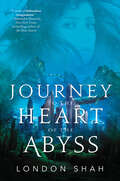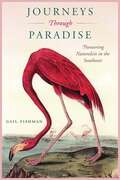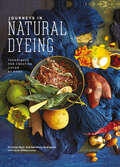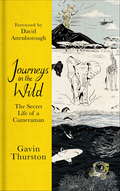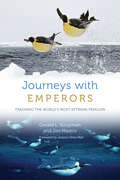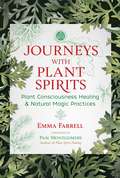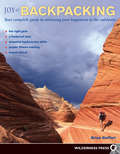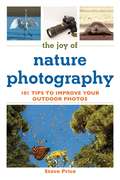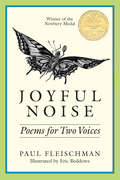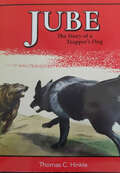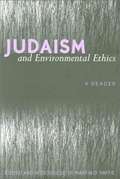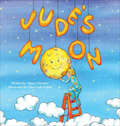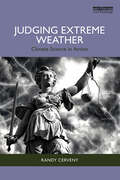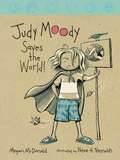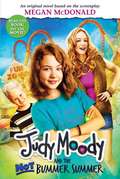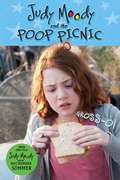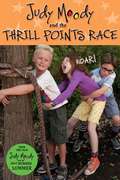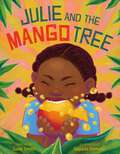- Table View
- List View
Journey to Dyatlov Pass: An Explanation of the Mystery
by Keith MccloskeyThis book describes the author's journey to the Dyatlov Pass in the northern Ural Mountains in the company of Russian Dyatlov "Obsessives". It is also a book for people who already know the Dyatlov story. The physical locations relating to the Dyatlov Incident are examined and discussed as well as competing theories from some of the group members about what happened. The second part of the book takes a critical look at the autopsies. This is followed by an intensive look at some ground-breaking research on the Dyatlov negatives by Valentin Gerasimovich Yakimenko. The final part of the book discusses the statements made by the two senior figures in the investigation and finishes with a scenario as to what may have happened on that fateful night of 1/2 February 1959.
Journey to Inspired Art Quilting: More Intuitive Color & Design
by Jean WellsDiscover your artistic voice Expand your creative horizons and embrace the process of developing your design skills using your own intuition. Jean provides you with more design guidelines and new exercises to hone your natural intuitive skills, then she encourages you to go out there and express yourself! Packed with inspiring quilt images, this book walks you through effective approaches to art quilting from journaling your ideas to unifying your design. • Continue your art quilting journey with Jean in this follow up to Intuitive Color & Design • Learn how to recognize those "big ideas" that become inspirational starting points for your art • 9 classroom-tested design assignments help you trust your creative instincts and develop distinctive work
Journey to the Crystal Cave (The Adventures of Sophie Mouse #12)
by Poppy GreenSophie discovers a mysterious crystal cave, but her friends don&’t believe her, in this twelfth charming book of The Adventures of Sophie Mouse series!Sophie Mouse and her friends are playing hide-and-seek near Butterfly Brook. Sophie finds the perfect hiding spot, but she finds something else, too! It&’s a glowing cave. The problem is, when Sophie tells her friends about her discovery, they don&’t believe her! After all, who&’s ever heard of a cave that glows? Now Sophie is on a mission to prove she&’s telling the truth! With easy-to-read language and illustrations on almost every page, the Adventures of Sophie Mouse chapter books are perfect for beginning readers.
Journey to the Heart of the Abyss (Light the Abyss #2)
by London ShahThe sequel to London Shah's thrilling futuristic mystery The Light at the Bottom of the World, perfect for fans of Illuminae and These Broken StarsLeyla McQueen has finally reunited with her father after breaking him out of Broadmoor, the illegal government prison—but his freedom comes at a terrible cost. As Leyla celebrates his return, she must grapple with the pain of losing Ari. Now separated from the boy who has her heart and labeled the nation&’s number one enemy, Leyla must risk illegal travel through unchartered waters in her quest for the truth behind her father's arrest.Across Britain, the fallout from Leyla's actions has escalated tensions between Anthropoid and non-Anthropoid communities, bringing them to an all-time high. And, as Leyla and her friends fight to uncover the startling truths about their world, she discovers her own shocking past—and the horrifying secrets behind her father&’s abduction and arrest. But as these long-buried truths finally begin to surface, so, too, do the authorities&’ terrible future plans. And if the ever-pervasive fear prevents the people from taking a stand now, the abyss could stay in the dark forever.
Journeys Through Paradise: Pioneering Naturalists in the Southeast
by Gail Fishman"This book is for those inhabited by the same desires that drove the early naturalists afield, who yearn to know wilder territory. We read it voraciously, as if in the understanding of how they loved we might also begin to do so, as if in the reliving of their lives we might recapture some vanishing part of the human psyche that must know wilderness."-- Janisse Ray, author of Ecology of a Cracker Childhood "Like the naturalists she profiles, Gail Fishman takes us on an odyssey through a time when the extraordinary diversity of the southeastern United States was first being explored and described. . . . Entertaining."-- Steve Gatewood, executive director, Society for Ecological Restoration, Tucson "Fishman modernizes the men and their explorations by retracing the terrain that they explored, wrote about, drew and painted. The result is an intriguing and appealing lesson in biographical and scientific history and a literary reading experience that will appeal to a wide audience."-- William W. Rogers, professor of history emeritus, Florida State University Following the original steps of pioneering naturalists, Gail Fishman profiles thirteen men who explored North America’s southeastern wilderness between 1715 and the 1940s, including John James Audubon, Mark Catesby, John and William Bartram, John Muir, and Alvan Wentworth Chapman. The book is also Fishman’s personal travelogue as she experiences the landscape through their eyes and describes the changes that have occurred along the region’s trails and streams. Traveling by horseback, boat, and foot, these naturalists--dedicated to their task and blessed with passion and insatiable curiosity--explored gentle mountains, regal forests, and shadowy swamps. Their interests ran deeper than merely cataloging plants and animals. They identified the continent’s foundations and the habits and histories of the flora and fauna of the landscape. Fishman tells us who they were and what compelled them to pursue their work. She evaluates what they accomplished and measures their importance, also pointing out their strengths and failings. And she paints an engaging picture of what America was like at the time. Fishman combines natural history and American history into a series of portraits that recapture the American Southeast as it was seen by those who first tramped through the wilderness and whose voices from the beginning urged the preservation of wild places. Gail Fishman, a freelance writer who lives in Tallahassee, has worked for the Florida Defenders of the Environment, The Nature Conservancy, and the National Audubon Society. She is a volunteer for the St. Marks National Wildlife Refuge and helped form the St. Marks Refuge Association.
Journeys in Natural Dyeing: Techniques for Creating Color at Home
by Kristine Vejar Adrienne Rodriguez Sarah Ollikkalla Jones“Beautifully written as part travel memoir and part dyeing handbook . . . you are handed a wealth of knowledge in one book.” —Little Acorn CreationsSimilar to cooking and the act of sharing meals, our relationship to textiles is a core tenet of our human experience. Creating textiles cultivates connection, belonging, community, and friendships among people. In the world of textiles, natural dyeing is the closest we come to the act of cooking. Journeys in Natural Dyeing shares the story of Kristine Vejar and Adrienne Rodriguez’s travels to four countries—Iceland, Mexico, Japan, and Indonesia—where they visited natural dyers who use locally-sourced dyes to create textiles that evoke beauty, a connection to their environment, and showcase their mastery of skill. This book shares their process of using their own locally-grown dyes and includes recipes and projects to create more than 400 shades of color. In addition, you will learn how to use your own natural environment to create deep, beautiful colors. No matter where you live, creating color naturally is possible.
Journeys in the Wild: The Secret Life of a Cameraman
by Gavin ThurstonFrom Gavin Thurston, the award-winning Blue Planet II and Planet Earth II cameraman with a foreword by Sir David Attenborough comes extraordinary and adventurous true stories of what it takes to track down and film our planet's most captivating creatures.Gavin has been a wildlife photographer for over thirty years. Against a backdrop of modern world history, he's lurked in the shadows of some of the world's remotest places in order to capture footage of the animal kingdom's finest: prides of lions, silverback gorillas, capuchin monkeys, brown bears, grey whales, penguins, mosquitoes - you name it he's filmed it.From journeys to the deepest depths of the Antarctic Ocean and the wide expanse of the Saharan deserts, to the peaks of the Himalayas and the wild forests of the Congo, Gavin's experiences describe much more than just the incredible array of animals he's filmed. He invites you to come inside the cameraman's hidden world and discover the hours spent patiently waiting for the protagonists to appear; the inevitable dangers in the wings and the challenges faced and overcome; and the heart-warming, life-affirming moments the cameras miss as well as capture.
Journeys with Emperors: Tracking the World's Most Extreme Penguin
by Gerald L. Kooyman Jim MastroWith stunning photographs from the ice edge, a firsthand account of a researcher’s time in Antarctica and of the perilous journeys of the world’s largest penguin species: the iconic emperor. Nearly all emperor penguin colonies are extremely remote; of the sixty-six known, fewer than thirty have been visited by humans, and even fewer have been the subject of successful research programs. One of the largest known emperor penguin colonies is found on a narrow band of sea ice attached to the Antarctic continent. In Journeys with Emperors, Gerald L. Kooyman and Jim Mastro take us to this far-flung colony in the Ross Sea, showing us how scientists gained access to it, and what they learned while living among the penguins as they raised their chicks. The primary mission was to record the birds’ activities at sea, and the data revealed important aspects of emperor penguin behavior and physiology: for instance, that in the course of hunting for food, some of the penguins dive to depths of greater than five hundred meters (a third of a mile, which is deeper than for any other diving bird). The researchers also discovered that, crucially, most of the emperor’s life is actually spent at sea, with fledged chicks and adults making separate, perilous journeys through icy water. When chick nurturing is complete, the fledglings abandon the colony in large groups, heading north to the Southern Ocean. The adults leave at the same time, traveling one thousand kilometers eastward across the Ross Sea to a sea-ice sanctuary for molting. During this journey, they must gain enough weight to survive the month-long molt, when every feather is replaced and the birds cannot enter the water to feed. After the molt, many if not most return to the colony to breed once again. For the males, this means another fast—this time for 120 days as they incubate their eggs. The nearness of the colony to the ice edge spared the penguins the long, energy-draining march for which other colonies are well-known. It also allowed researchers to observe the penguins’ departures to and arrivals from their foraging journeys, as well as their dangerous interactions with leopard seals and killer whales. Featuring original color photographs and complemented with online videos, Journeys with Emperors is both an eye-opening overview of the emperor penguin’s life and a thrilling tale of scientific discovery in one of the most remote, harsh, and beautiful places on Earth.
Journeys with Plant Spirits: Plant Consciousness Healing and Natural Magic Practices
by Emma Farrell• Presents meditation journeys with specific plant and tree spirits, such as Mugwort, Rosemary, Dandelion, Yew, Elder, and Wormwood • Details how to achieve a calm mind, cleanse your energy field, and connect with your heart in preparation for meditating with the plants • Includes a progressive series of introductory meditations, adapted from wisdom traditions, to lay the foundation for working with plant spirits Our ancient ancestors understood the language of nature, enabling them to communicate innately with plants. By quieting the mind through meditation, we too can tap into the vibratory resonance of plants and receive their wisdom and healing. In this guide, Emma Farrell explains how to take your connection and relationship with nature to a deeper level and access plant spirit healing through meditation with plants. She explores the nature of plant consciousness and how plants perceive, drawing on indigenous and shamanic teachings. She details how to achieve a calm mind, cleanse your energy field, and connect with your heart in preparation for meditating with plants and trees, showing how the plants can support us not only in the cleansing process but also in teaching us how to sense what is in our energy field. Offering a progressive series of preparatory meditations, adapted from wisdom traditions, the author reveals how to lay the foundation for working, communicating, and developing relationships with plant and tree spirits for personal development, spiritual connection, and inner peace. She then presents meditation journeys with specific plant spirits, focusing on specific frequencies within the plant&’s bio-resonance to assist you. For example, the meditation with Mugwort works with the plant spirit&’s qualities of alignment and self-awareness to assist you with grounding and developing inner vision, while the meditation with Dandelion helps you break old habits by working with the plant&’s qualities of release, reconnection, and fearlessness. Revealing how each plant is an expression of the soul force of Mother Nature and carries a unique blend of her medicine and wisdom, this guide details step-by-step how to effectively work with plant spirits for emotional and spiritual healing, enabling you to awaken the eternal spirit, or soul, to become truly multidimensional and whole.
Joy Adamson's Africa
by Joy AdamsonFrom the Book Jacket: Joy Adamson is a woman of many talents and immense energy. This lavishly illustrated volume reveals the scope of her interests and achievements as wood carver, flower painter, portraitist of birds, fish, insects, animals and people. In a delightfully vivid text keyed to the illustrations, joy Adamson tells about the background of her work in the visual arts. Married to a botanist, who took her to Kenya, she started collecting and painting the indigenous flora of East Africa. Exploring the coral reefs of the Indian Ocean, she sketched the coral fish on the reef before their colors faded. She painted whatever aroused her interest : insects, reptiles, shells, and what she calls the wonders of nature-insects that shape themselves into flowers, and other forms of ingenious camouflage. On a Government commission, she made a record of the customs and costumes of the Kenya tribes, spending over six years living among these Africans, often in very isolated places. After her marriage to George Adamson, a Senior Game Warden of the Northern Frontier District, she became foster mother of lions, elephants, monkeys, a tree hyrax, a buffalo, and started her sensational work with cheetah. Living constantly near wild animals, she observed them at close range and made many sketches. This rich and varied life is here documented in pen and brush, a delight for lovers of nature and admirers of a gifted, intrepid woman, a pioneer in ecological concern.
Joy of Backpacking
by Brian BeffortA comprehensive guide covering every aspect of how to backpack--from planning a first trip to advanced wilderness travel. For those new to the activity, longtime backpacker and author Brian Beffort covers the fundamentals, with sections on trip planning, gear, backcountry nutrition and cooking, navigation, and other essential wilderness skills. You will also learn what to expect on the trail and in camp, and how to stay safe with first aid, weather preparedness, and more. For experienced packers, this book is filled with practical tips and inspired ideas on how to update and refine your approach to backpacking based on trends in lightweight gear, high-tech gadgets, changing wilderness rules, and increasing opportunities for wilderness travel around the world.
Joy of Nature Photography: 101 Tips to Improve Your Outdoor Photos (Joy of Series)
by Steve PriceThe best tips anyone can use to take better outdoor pictures. Nature and the outdoors provide us with exceptional beauty year-round. Now, author and professional photographer Steve Price has put together a collection of tips, tricks, and pointers for any photographer--amateur or pro--to take and develop excellent outdoor and wilderness photos. The Joy of Nature Photography is an informative, entertaining, and easy-to-understand book that will help you take your best nature pictures, no matter where you are. Broken into eleven chapters, this book combines technical know-how and real-life examples to offer tips that cover all the basics of photography. Each tip is carefully explained, and every chapter features stunning photos by the author to demonstrate particular methods. The Joy of Nature Photography will help anyone hone their skills as an outdoor photographer, and it provides experienced wisdom on topics such as: Choosing your equipment Composing your image Shooting with a smartphone Special wildlife photography techniques And more! From taking photos of leopards in Africa to grizzlies in Alaska, and from using the latest zoom lens to snapping a quick pic with your phone, The Joy of Nature Photography will give you the tools and knowledge you can use to capture the beauty of the wilderness and wildlife you love.
Joyas voladoras (¡Arriba la Lectura!, Level I #67)
by Katacha DíazLos colibrís son las aves más pequeñas que existen. Algunos los llaman joyas voladoras. En este libro aprenderás muchos datos interesantes sobre los colibrís. NIMAC-sourced textbook
Joyful Noise: Poems for Two Voices
by Paul FleischmanWritten to be read aloud by two voices—sometimes alternating, sometimes simultaneous--here is a collection of irresistible poems that celebrate the insect world, from the short life of the mayfly to the love song of the book louse. Funny, sad, loud, and quiet, each of these poems resounds with a booming, boisterous, joyful noise.<P><P> In this remarkable volume of poetry for two voices, Paul Fleischman verbally re-creates the "Booming/boisterious/joyful noise" of insects. The poems resound with the pulse of the cicada and the drone of the honeybee. Eric Beddows′s vibrant drawings send each insect soaring, spinning, or creeping off the page in its own unique way.<P> Paul Fleischman has created not only a clear and fascinating guide to the insect world—from chrysalid butterflies to whirligig beetles—but an exultant celebration of life.<P> Newbery Medal Winner
Jube: The Story of a Trapper's Dog
by Thomas C. HinkleFelix was the most experienced wolf trapper of the plains, but there was one wolf that he had never been able to outwit, a wolf that the men called Old Rip. She had only contempt for men and their traps and poison, and she knew enough to keep out of rifle range. So when one day a stranger brought a big gray pup with a ring of white around his neck to Cole Campbell's ranch, Felix saw in him the makings of a great wolf dog—and a chance to kill Old Rip—who had been the scourge of the cattlemen for years. Jube quickly captured the hearts of all the men by his bravery, his gentleness, his almost human intelligence. He learned never to stray too far from Felix, his master. Together, Felix and the great dog roamed the plains, searching for Old Rip. Many times she eluded them. Once Jube was almost killed by the poison Felix put out for the wolves. But as Jube grew older and stronger, Felix's hopes for trapping the dangerous wolf increased. And one day in a battle to the death, Jube proved the greatness of his heart.
Judaism and Environmental Ethics: A Reader
by Jeremy Cohen Martin D. Yaffe E. L. Allen Bradley Shavit Artson Jeremy Benstein Joan G. Ehrenfeld David EhrenfeldMartin D. Yaffe's Judaism and Environmental Ethics: A Reader is a well-conceived exploration of three interrelated questions: Does the Hebrew Bible, or subsequent Jewish tradition, teach environmental responsibility or not? What Jewish teachings, if any, appropriately address today's environmental crisis? Do ecology, Judaism, and philosophy work together, or are they at odds with each other in confronting the current crisis? Yaffe's extensive introduction analyzes and appraises the anthologized essays, each of which serves to deepen and enrich our understanding of current reflection on Judaism and environmental ethics. Brought together in one volume for the first time, the most important scholars in the field touch on diverse disciplines including deep ecology, political philosophy, and biblical hermeneutics. This ambitious book illustrates--precisely because of its interdisciplinary focus--how longstanding disagreements and controversies may spark further interchange among ecologists, Jews, and philosophers. Both accessible and thoroughly scholarly, this dialogue will benefit anyone interested in ethical and religious considerations of contemporary ecology.
Jude's Moon
by Nancy GuettierNighttime is the best time for a boy and his best friend in this charming tale from the author of Circus in the Sky and Mermaids on Mars. Jude’s Moon is a delightful story of a little boy who is fascinated by the moon. He believes he is the only one who can see it, so he is always so excited to point it out to his mom. “There’s the moon!” he shouts with glee every time he sees it. One day Jude is confused when the moon changes shape. He thinks someone has stolen his moon and replaced it with a croissant. When he learns it is a crescent moon, he is even more curious to learn how it changes shapes. This story is a fun and easy way to educate children on the phases of the moon. “I recommend this book to kids that love science, teachers that want to teach their class about moon phases and parents that love to read with their kids.” —5 Girls Book Reviews “In Jude’s Moon, Jude loves the moon so much that he believes he is the one who hung it in the sky. Throughout the story, Jude examines the phases of the moon, as well as fun facts about the sun.” —MySocialGoodNews.com
Judging Extreme Weather: Climate Science in Action
by Randy CervenyWritten by the World Meteorological Organization (WMO) Rapporteur of Weather and Climate Extremes, this book addresses the reality of extreme weather—how it occurs, how we measure it, and what it means for our future. Weather affects everybody, and with the increasing impact of climate change and the prevalence of storms, droughts and floods, it is clear that we are affecting all aspects of weather. Consequently, people love to talk about weather, complain about it, argue about it—and be intrigued by it. Twenty-four/seven coverage of the weather, however, has helped foster a tendency for marked overstatement—the creation of misconceptions, exaggerations and, frankly, even outright lies. Leading expert in weather and climate, Randy Cerveny, draws on his extensive experience with the WMO and personal research to give the reader a behind-the-scenes look at how weather and climate extremes are recorded and defined. He unpacks the science behind these extremes through a number of specific WMO investigations that span a diverse range of countries and weather events, including lightning, rain, hurricanes and tornadoes. Cerveny balances these factual accounts with playful interludes that detail bizarre and intriguing weather-related stories and anecdotes. This compelling book is a must read for all those interested in the science behind extreme weather.
Judy Moody Saves the World! (Judy Moody #3)
by Megan McdonaldThe mercurial Judy returns - and she's in a mood to take on the world! Get ready for the newest installment in the hilarious Judy Moody series. Rare! Judy Moody did not set out to save the world. She set out to win a contest. A Band-Aid contest. It all started with the Crazy-Strip contest - and the dream that she, Judy Moody, might one day see her very own adhesive-bandage design covering the scraped knees of thousands. But when her "Heal the World" motif merits only an honorable mention, Judy Moody realizes it's time to set her sights on something bigger. Class 3T is studying the environment, and Judy is amazed to learn about the destruction of the rain forest, the endangered species (not) in her own backyard, and her own family's crummy recycling habits. Now she's in a mood to whip the planet into shape - or her name isn't Judy Monarch Moody!
Judy Moody and the NOT Bummer Summer
by Megan McdonaldJudy's big plans for the summer seem ruined when two of her best friends go away, and then her parents leave her and Stink with Aunt Opal, but a new "thrill-a-delic" plan has her racing toward fun.
Judy Moody and the NOT Bummer Summer: The Poop Picnic
by Megan McdonaldJudy is desperately trying to earn thrill points, so she plans a trip to the Cemetery Creep n Crawl. Meanwhile, Stink has been collecting all the samples and evidence he can in his efforts to catch Bigfoot. Add in Aunt Opals crazy driving (and bad sense of direction), and somehow they all end up at an abandoned amusement park, eating scat sandwiches. That's got to be worth some thrill points. . . .
Judy Moody and the NOT Bummer Summer: The Thrill Points Race
by Megan Mcdonald Jamie MichalakJudy Moody is psyched for summer - that is until she realizes that two of her three best friends aren't going to be around: Rocky will be teaching lions to jump through hoops at circus camp, and Amy is going to be searching for lost tribes in the rain forests of Borneo. How can Judy's summer ever compare? But she is determined that her summer will NOT be a bummer, that she and Frank Pearl will have the most NOT bummer summer ever - with plenty of thrill points to prove it!
Jugamos en la nieve (¡Arriba la Lectura!, Level D #18)
by Annette Smith Lyz Turner-ClarkKate y mamá pasan un día divertido. Kate le escribe a papá para contarle todo. NIMAC-sourced textbook
Julie and the Eagles (American Girls #4)
by Megan McdonaldJulie and Ivy are eating snow cones in Golden Gate Park when they hear an odd sound. It's a baby owl-and it needs help. At a wildlife rescue center, Julie meets Shasta and Sierra, two bald eagles. Shasta's wing is injured, and Julie hopes he'll be able to fly again-but that can happen only if the rescue center raises enough money to release the eagles back into the wild. Julie feels sure that if people knew about the eagles, they'd want to help. For Earth Day, Julie thinks of a unique way to tell the public of the eagles' plight. But money isn't exactly pouring in ... and time is running out.
Julie and the Mango Tree
by Sadé SmithCoupled with Sayada Ramdial’s bright and colorful artwork, Julie and the Mango Tree by Sadé Smith will have readers of all ages giggling—and craving a mango of their own! <P><P>Julie loves all kinds of fruit, but mangoes are her absolute favorite. One sticky summer afternoon, Julie goes to the big mango tree in her yard to ask for a snack. But no matter how nicely she asks or how patient she tries to be, the tree just won’t drop a single sweet, juicy mango! Will Julie ever be able to convince the tree to let her have just a taste of her favorite treat?
